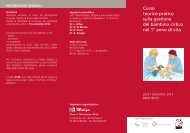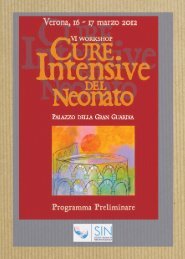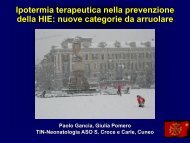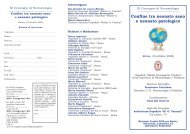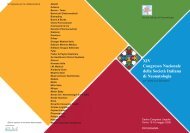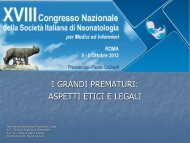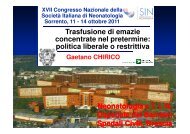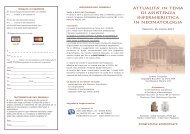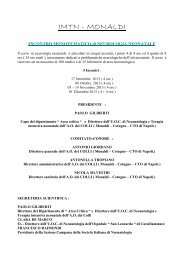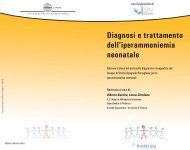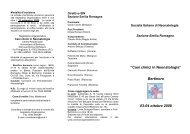invasive respiratory support
invasive respiratory support
invasive respiratory support
- No tags were found...
You also want an ePaper? Increase the reach of your titles
YUMPU automatically turns print PDFs into web optimized ePapers that Google loves.
NRS - Indications NRS has been used for:1. The initial treatment of RDS,2. Post extubation as a "bridge" tospontaneous un<strong>support</strong>ed breathing,3. Apnea of prematurity.
Nasal Respiratory Support(NRS) NCPAP - nasal continuous positiveairway pressure NIMV - nasal intermittent mandatoryventilation HFNC – high flow nasal cannula (?)
IntroductionOwen (ArchDis Child Fetal Neonatal Ed. 2008) recently concludedthat in the practical approach in England, NIMV iscommonly used, with considerable variability in thetechniques applied.The wide range of clinical approaches highlights thepaucity of evidence available.Data on term infants are lacking and we will focus onpreterm infants.The following suggested practical approach is basedon the current literature.
Initiating nasal <strong>respiratory</strong><strong>support</strong> (NRS)
Nasal continuous positiveairway pressure (NCPAP)NCPAP goal in infants with RDS is to maintain lung recruitment or ofunctional residual capacity (FRC).The level of pressure should achieve this goal withoutcompromising circulatory or ventilatory function. A pressure of 4-646 cm H2O usually will be adequate.Meta-analyses analyses of CPAP studies suggest that a pressure of at least5 cm H2O is needed to provide benefit over ambient oxygen.Higher pressures up to 8 cm H2O were used by someinvestigators, but at least in one study the rate of pneumothoraxusing such pressure was relatively high (Morley CJ, N Engl J MedJ Med. . 2008).
Nasal intermittent mandatoryventilation (NIMV) The ventilator settings used for NIMV ornasal synchronized intermittent mandatoryventilation (NSIMV) are not similar in allstudies. The effects of different initial settings on thesuccess of NIMV and of manipulating thesettings on clinical status have not beeninvestigated.
PEEP during NIMV No study has investigated the optimal levelof positive end expiratory pressure (PEEP)during NIMV. It is probably adequate to adopt therecommendations for NCPAP, as CPAP tomaintain FRC in treating RDS is the basis forNRS and the intermittent mandatoryventilations used in NIMV are just added ontop of the CPAP.
PIP during NIMVNo studies have investigated optimal peak inspiratorypressure (PIP) during NIMV.Some NIMV studies used a PIP similar to that used duringventilation, whereas others used pressures 2–424 cm H2Ohigher than pre-extubation extubation PIP.One study used enough pressure ‘‘to see the chest rise’’’’,, andothers chose specific target pressures (16–20 cm H2O).Ryan et al (Am J Dis Child 1989) noted that despite a set pressureof 20 cm H2O the pressure generated at the proximal end ofthe nasal prongs was highly variable (range 8–218cm H2O;mean 10 cm H2O).
Rate and Flow on NIMVThe optimal rate of inflation during NIMV has not beeninvestigated. A range of rates have been used, mainly 10–25/minute.There were reports on the use of assist control mode, inwhich every infant-initiated initiated breath is <strong>support</strong>ed by a ventilatorinflation.No study has investigated the flow to use in the circuit duringNIMV.The circuit flow, and the leak from the device, will influencethe PIP achieved during each inflation.
Summary NIMV We suggest (KugelmanA, J Pediatr. 2007) choosing theinitial ventilator settings according tothe indication for NIMV.
NIMV- Ventilator settings(KugelmanA J Pediatr. 2007). Initial treatment of RDS: Rate of 12-30 breaths per minute (accordingto PaCO2), Inspiratory time of 0.3 seconds, PEEP of 6 cmH2O, PIP of 14-22 cmH2O according to chestexcursion and the infant's weight. FiO2 to keep oxygen saturation by pulseoximetry between 88-92%
NIMV- Ventilator settings After extubation: Those used on endotrachealventilation prior to extubation, or, Only "sigh" ventilation
Nasal flowIts use is popular because it allows easy access tothe infant and enables the parents to hold theinfant.Nasal cannulae have been used to deliver oxygen atflow rates of 0.5 liter/minute to as high as 6liter/minute, usually with no intention of deliveringCPAP.However, a significant amount of CPAP is generated("inadvertent CPAP"), and is not measuredcontinuously at the bedside (Sreenan.. Pediatrics 2001).
NCStandard or low flow nasal cannula is limited by inadequatehumidification and unheated air flow.Delivery of such a gas may lead to airway dysfunction andnegative <strong>respiratory</strong> outcomes.Cooling and loss of water from the airways may impairmucociliary transport, increase fluid osmolality, , promotebronchospasm, , and increase the viscosity of airwaysecretions.Moreover, considerable energy is required to heat and tohumidify gas delivered into the nose, potentially interferingwith optimal nutrition and growth.
NCOn the basis of studies with VLBW infants undergoingventilation, the delivery of nonhumidified gas may lead toincreases in air leaks, more-severe chronic lung disease,impaired surfactant activity, and changes in pulmonarymechanics.Delivery of cold, relatively dry gases, particularly at high flowrates, to the nose may also lead to nasal mucosal injury andbleeding, resulting in pain and creating a portal of entry forinfectious agents.The warmed and humidified new delivery HFNC devicesovercome the disadvantages of commonly used nasal cannulatherapy.
HFNCHFNC delivers flow rates that exceed patient inspiratory flowrates at various minute volumes.High flows result in washout of anatomical and physiologicaldead space and contribute to improved fractions of alveolargases with respect to carbon dioxide as well as oxygen.One must exercise caution when delivering flow rates greaterthan 2 liter/minute via nasal cannula without knowing theamount of pressure delivered.This is also true for the warmed and humidified new deliverysystems.
HFNC Kubicka et al (Pediatrics.2008) concluded thatHFNC therapy using cannulae of 0.2-cm outerdiameter can generate some level of CPAPwhen the mouth is closed. The amount of pressure generated wasrelated to the flow rate, the size of the leakaround the nasal cannula, , and the degree ofmouth opening. They also raised the important safety andmonitoring issues for the use of thesedevices.
HFNCThey speculated that if the nasal leak is eliminatedwith the use of cannulae that obstruct the narescompletely, then dangerously high distendingpressures may be generated when the mouth isclosed.Thus, they suggested that HFNC therapy should notbe used as a routine replacement for CPAP therapy.To use HFNC we suggest: : create/allow leak byusing the nasal prongs no larger than 1/2 thediameter of the nares and do not allow chin rap.
Suggested protocol and rationalefor HFNCThere are no precise data currently on therelationship between flow and generated CPAP onHFNC, and fluctuations may occur depending onflow, infant weight and the level of leak accordingto cannula size and opening of the mouth.Continuous CPAP measurements on HFNC are notfeasible yet.We depicted our flows by integrating the knowninformation from the literature taking margins ofsafety and not aiming to create CPAP.
HFNCKubicka (Pediatrics.2008 has shown that the highest mouth pressureachieved was 4.5 cm H2O (flow rate: 8 l/m) ) with outer diametercannula of 0.2 cm.Others used esophageal pressure measurements to estimatedistending pressures generated in premature infants and foundconflicting results.Locke et al (Pediatrics 1993) reported that the equivalent of 9.8 cmH2O could be generated with only 2 l/m of flow by using a nasalcannula of 0.3 cm outer diameter.Sreenan et al (Pediatrics 2001) reported that clinically relevant levels ofCPAP could be generated with flow rates of 1 to 2.5 l/m.Saslow (J Perinatol 2006) found no significant increase in enddistending pressure from baseline with flow rate lower than 5 l/m.
HFNCRecently, Quinteros et al (SPR, Baltimore, 2009 ) measuredhypopharyngeal pressures delivered by nasal cannula inpremature infants (989+556 g) at 43+25 days, and reportedmaximal pressures (median [range]) of 4.7 [1.3-19] 19] on 1l/min and 5.4 [4.0-20.4] cm H2O on 2 l/min.Peak pressures >15 cm H2O were frequently observed withgas flows >2 l/min in infants
HFNC- protocol Flows will be started on 1 l/m. Flows between 1.0-3.0l/m in infants 1000g (where the leak may be larger). FiO2 will be set to keep oxygen saturationby pulse oximetry between 88-92%.
Ventilator settingsadjustments during NRStherapy
Nasal continuous positiveairway pressure (NCPAP)Pressures may be increased for lung recruitment in severe RDS(usually up to ~8 cm H2O), while monitoring the hemodynamiceffects in the individual patient and chest radiograph to avoidhyperinflation.When treating the acute phase of RDS in the very prematureinfant, one should consider intubation and surfactantadministration instead of increasing the CPAP level.NCPAP pressure may be weaned in the recovery stages of RDSas lung compliance improves to avoid over-distention. We wean infants to spontaneous un<strong>support</strong>ed breathing from 4-46 cm H2O.We usually do not use lower pressures.
Nasal intermittent mandatoryventilation (NIMV)The setting of NIMV during the time the infant requires NRSare adjusted to maintain the goals of adequate oxygenationand ventilation (permissive hypercapnia).Oxygenation is maintained by FiO2 and mean airway pressure(inspiratorytime [IT], peak inspiratory pressure [PIP] andCPAP level), and ventilation by the <strong>respiratory</strong> rate, expiratorytime, PIP, and maintaining adequate CPAP, according to therules of conventional endotracheal ventilation.Yet, this routine was not tested in controlled trials.
Nasal intermittent mandatoryventilation (NIMV)For example, no study has shown that higher rates on theventilator change the PaCO2, while the baby is breathingspontaneously and complements the NRS.Yet, increasing the rates may decrease the work of breathing.Meta analysis of two trials comparing NIMV and NCPAP ininfants with apnea demonstrated no difference with regard tocarbon dioxide levels after 4-646 hours of <strong>support</strong> (Tarnow-MordiWO, JPediatr. 1989).Nasal ventilation <strong>respiratory</strong> settings need to be furtherstudied to allow evidence based recommendation.
Nasal flow-HFNCOxygen should be monitored to keep the requiredoxygen saturation.An oxygen/room air mixer/blender is required toassure limitation on the higher level.The CPAP created at different flows of HFNC needsto be studied to guide a controlled use, if one'sintention is to create CPAP with nasal flow.
HFNC Flows can be increased at intervals of 1 l/m according to theinfant's weight and as needed according to the clinicalcondition (<strong>respiratory</strong>[retractions, <strong>respiratory</strong> rate, grunting]and hemodynamic [blood pressure and heart rate]), andaccording to ABG (ventilation [PaCO2] and oxygenation).There are fluctuations that are not continuously measuredand this may create obstacles in using formulas createdaccording to flow, gestational age and weight (Kubicka2008).Kubicka. Pediatrics.Certainly, a high flow limitation should be kept to avoid thecomplications of air leak.
Criteria for failure of nasal <strong>support</strong>Differ between studies, and in our study (KugelmanA. J Pediatr. 2007) were:Clinical deterioration [increased <strong>respiratory</strong> distress] accompaniedby at least one of the following or worsening of the following:1. pH60 mmHg,2. PaO2
NRS side effects
Short term side effectsNRS seems to be safe.Of some concern is the study of Morley et al (N Engl JMed. . 2008) that reported higher incidence ofpneumothorax (9%) in the CPAP group (8 cmH2O),as compared with 3% in the intubation group(P
GI There was a concern that NIMV might causemore gastrointestinal complications thanNCPAP because of gastric distention leadingto cessation of feeds or perforation. However, no gastrointestinal complicationswere reported in other studies and time tofull feeds was similar in the two methods.
Early NCPAP and NEC in preterminfants (Aly.. Pediatrics 2009).Data on 343 premature infants were collected for thisstudy. Mean BW was 999+289 g and GA was 28+2.62.6weeks.The majority of patients were managed with ENCPAP,with only 13% of patients intubated in the deliveryroom. The overall incidence of NEC was 7% (n=24).The exposure to ENCPAP did not increase the risk forNEC.
NRS - Short term effectsThe discomfort related to NRS may be ofimportance and deserves our attention for twomain reasons:First, our aim is to be gentle and to keep a policyof ‘minimal handling' in the care of prematureinfants (avoid pain, noise, local trauma).Second, an irritable infant who ‘fights’ the NRSmay be exposed to a higher risk ofpneumothorax.
Discomfort NRS may irritate the infants because thenasal flow causes high noise-levels. Surenthiran et al (ArchDis Child Fetal Neonatal Ed. 2003)reported mean noise intensity in the ear at1 kHz of 55 dB, higher on NCPAP comparedwith spontaneous breathing or conventionalventilation, and up to 102 dB at somefrequencies.
DiscomfortNRS may cause pain and irritation in relation tonasal flow, high pressure in upper airways and localpressure and trauma.Adequate techniques for fixation of the NRS devicesthat minimize the friction and direct pressure on thenose may decrease these undesired local effects.Devices that deliver humid and warm nasal flowwere shown to reduce the rate of nasal mucosainjury as compared to standard HFNC.
Oral CPAP following nasalinjury. (Carlisle. Arch Dis Child Fetal Neonatal Ed. 2010 )
Physiological parametersNRS may affect physiological parameters during RDS andwhile the babies are stabilized, at the phase of recoveringfrom RDS.Yu et al (ActaPaediatr Scand. 1977) concluded that with correct useof NCPAP, an improvement in oxygenation generally occurswithout obvious adverse cardio-<strong>respiratory</strong> <strong>respiratory</strong> effects.However, when appropriate pressures are exceeded it ispossible that both circulatory and ventilatory function mightbe severely compromised, possibly by over distension and adecrease in the venous return.
Physiological parametersAND DiscomfortKugelman et al (ActaPediatr. . 2008) concluded that NRS in ‘stable’premature infants is associated with increased blood pressureand increased discomfort, despite a decreased <strong>respiratory</strong>rate.The clinical importance of these effects was modest.While these findings are reassuring when NRS is needed, theyshould be considered when the medical team balances itsneed and advantages with its adverse effects according to theclinical condition of the infant.To minimize the discomfort related to NRS, we should shortenits use when possible
Practical hints forneonatal NRS applicationDifferent techniques of NRS are available.Short binasal prong devices are more effective than single prongs ornasopharyngeal prong ( De Paoli. Cochrane Database Syst Rev. 2008).Infant flow driver uses a fluidic flip system that has been shown toassist spontaneous breathing and reduce work of breathing byreducing expiratory resistance and maintaining a stable airwaypressure throughout the <strong>respiratory</strong> cycle.It was also shown to provide better lung recruitment compared to tcontinuous flow NCPAP.However, the infant flow driver was found to be as effective asconventional CPAP in preventing extubation failure among ELBWinfants (Stefanescu. Pediatrics. 2003).
Bubble CPAPBubble CPAP, , is accomplished bysubmerging the expiratory limb of the<strong>respiratory</strong> circuit within a fluid column.The generated pressure is determinedby the depth of submersion and isindependent of flow rate.It has been shown to be more successful than thestandard CPAP (Pillow JJ Am J Respir Crit Care Med. 2007,Perinatol. . 2003).. 2007, Narendran V JBubble CPAP may also provide an inexpensive form ofCPAP with some characteristics of non<strong>invasive</strong> HFV.
Bubble CPAPIn a randomized crossover trial (Morley.Arch DisNeonatal Ed. 2005), 26 babies treated with nasal prongCPAP from a bubbling bottle, received vigorous,high amplitude, or slow bubbling for 30 minutes.Dis Child FetalPulse oximetry, transcutaneous carbon dioxide, and<strong>respiratory</strong> rate were recorded.The bubbling rates had no effect on carbon dioxide,oxygenation, or <strong>respiratory</strong> rate.
Synchronized NIMV Finally, there are different methodsthat try to synchronize NIMV. However, while NSIMV may bepreferred over NIMV, this was notdemonstrated and synchronization isprobably not mandatory (KugelmanA, J PedsPeds 2007).
Nursing during NRS Good quality nursing during NRS careis of uttermost importance. The success of the treatment relies onoptimal positioning of the baby,maintaining patency of the upperairways and avoiding loss of thepositive airway pressure.
Key points for NRS nursing careaccording to Bohlin et al (Neonatologyour own experience:andNeonatology. . 2008) andKeep an open nasal passages;Find the optimal comfort body position for theinfant and keep the head in mild extension to keepan open airway with a neck <strong>support</strong>;Use preterm pacifier to minimize loss of pressurefrom open mouth or keep the mouth close with chin<strong>support</strong> to achieve adequate CPAP; caution!!Try to avoid suctioning the nose and use salinedrops instead and then suction the oropharynx;Use adequate humidification and temperature ofgases;
Key points for NRS nursing careaccording to Bohlin et al (Neonatologyour own experience:andNeonatology. . 2008) andAvoid using excessive force when fixating the nasalprongs;Do not pull tightly the nosepiece against the noseand keep it under the nose;Protect the nose with manufactured or "homemade" materials;Use the largest size prong that will sit without<strong>support</strong> in the nose;Inspect the fixation when you see that thenosepiece is pressing too tightly against the nose orthe NRS pressure is difficult to hold;Change to a larger prong as the baby grows.
Key points for NRS nursing careaccording to Bohlin et al (Neonatologyour own experience:andNeonatology. . 2008) and Some studies suggested using a gastrictube, open to air, to avoid gaseousdistension of the stomach during NIPPV,although there is no evidence that thisworks. We remove the air from the stomach atleast twice every 8 hours to avoid over-distention and open the NG 1 hr afterfeeding.
Weaning NRS Weaning by slowly reducing CPAP pressureshas been shown to be superior tointermittent pausing (Singh S, Abstract, Europediatrics,Barcelona, October 2006). Logically, pausing can result in alternatinghyperinflation with collapse of alveoli(atelectato-trauma) trauma) known to be associatedwith development of BPD.
Weaning from non-<strong>invasive</strong><strong>respiratory</strong> <strong>support</strong> in thepremature infantLength of NRS depends on the indication (RDS orapnea), gestational age, weight and possible sideeffects and there are no clear guidelines as towhen to stop NRS. Infants with RDS were allowed to stop NRS1. FiO2
Weaning NRS Two approaches to weaning from NRS arepossible. 1. Wean pressures and rate as performedwhile on conventional ventilation, weaningfirst those parameters that may cause lungdamage. 2. Use cycles of NRS and spontaneousbreathing and allow exercising the<strong>respiratory</strong> muscles.
Weaning NRS The preferred method of weaningfrom NRS needs to be studied. The way to wean from NRS may beimportant, but it is possible that thisissue has a neglected role in the finaloutcome.
Potential hazard of the Neopuff T-pieceresuscitator in the absence of flow limitation.(Hawkes CP, Arch Dis Child FetalNeonatal Ed 2009) Even an increase in flow from 5 to 15l/min will bring about a fourfoldincrease in PEEP, a serious potentialhazard of the Neopuff.
Neopuff (Morley. Arch Dis Child Fetal Neonatal Ed. 2009) The practical message for all who use the Neopuffis that it should be used according to themanufacturer’s instructions. 1. The recommended operating gas flow range is 5to 15 l/min. It specifically says, ‘‘Do not attempt touse a flow higher than 15 l/min.’’ 2. Adjust the gas supply to the desired flow ratebetween 5 and 15 l/min. Only then, set the PIP andPEEP. 3. The Neopuff should only be used on a baby afterchecking that correct pressures will be delivered tothe baby.
Neopuff (Morley. Arch Dis Child Fetal Neonatal Ed. 2009) The practical clinical messages are simple:1. Choose a flow rate you are going to use; wesuggest 8 l/min should be more than adequate; setthe PEEP and PIP, and then do not alter the flow.2. If the PEEP and PIP are not being delivered duringthe resuscitation, this is due to a large leakbetween the mask and face, and that should becorrected by altering mask position and hold, andnot by increasing the flow.
NASAL VENTILATION INOUTLYING NICUsEven the basic procedure of endotracheal ventilation requiresskills that are not trivial.Only 62% out of 60 attempts were successful in 31 infantsduring neonatal resuscitation (O'Donnell CP Pediatrics. . 2006). Success rates and mean+SDtime to intubate: Residents: 24%, 49+13 sec; Fellows: 78%, 32+13 sec; Consultants: 86%, 25+17 sec.Infants frequently deteriorate during intubation attempts.Thus, to avoid these, NRS is required.
NASAL VENTILATION INOUTLYING NICUs Modern mechanical ventilation requiresskilled personal and expensive equipment. NRS and Surfactant reduce need formechanical ventilation (avoiding transport). CPAP was found to be safe for transport(Murray, Pediatrics 2008).
NASAL VENTILATION-ExperienceThe use of NRS is also more successful inexperienced medical teams.Aly (Pediatrics.2004 ) showed that the number of ELBWinfants who were started on early NCPAP butintubated within 1 week (CPAP failure) decreasedover time (38.5% vs. 13.8% vs. 7.4%, respectiveto 3 terciles since the institution of early NCPAPsystem).They concluded that the frequency of use of earlyNCPAP in ELBW infants and its success improved intheir unit over time.
Essentials to remember: 1. Maintaining FRC is essential for the treatment of RDS inall modes of NRS. This is not the rule for HFNC. 2. Data on ventilator settings on NRS needs to be furtherstudied for effective and safe use. 3. NRS is safe. However, possible side effects should bemonitored and prevented. 4. NRS is beneficial, but when the infant is "ready" to wean,try to take him off NRS. 5. The comfort of the infant needs no be maintained whileon NRS.
Thank you !!!!!



